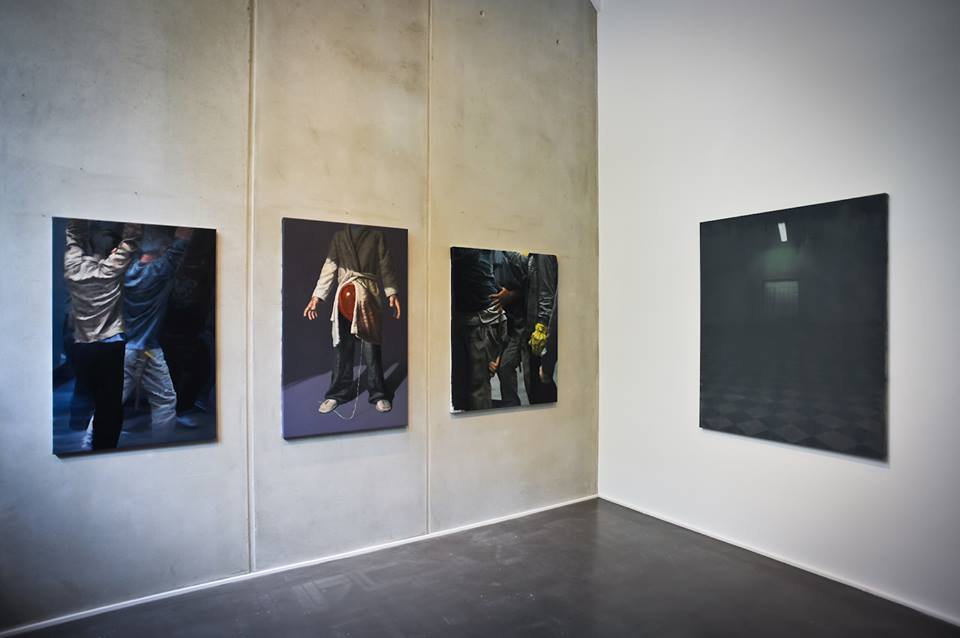 A few weeks ago, opened Argentinian artist Diego Cirulli ‘ Hollow’ his first solo exhibition in Europe at BC Gallery in Berlin unveiling a superbe body of work consisting of paintings created during 2015 and the first half of 2016 in Buenos Aires, Argentina, and where their only common denominator is that they all have their origins in the concept of loss. They are vestiges of what once was or happened, the pictorial materialization of what has become void and what remains.
A few weeks ago, opened Argentinian artist Diego Cirulli ‘ Hollow’ his first solo exhibition in Europe at BC Gallery in Berlin unveiling a superbe body of work consisting of paintings created during 2015 and the first half of 2016 in Buenos Aires, Argentina, and where their only common denominator is that they all have their origins in the concept of loss. They are vestiges of what once was or happened, the pictorial materialization of what has become void and what remains.
“… we need to close our eyes in order to see when the act of seeing sends us to – opens, an abyss that watches us, concerns us, and somehow constitutes us”. G. Didi-Huberman
As mentioned above, each of the works on display was conceived independently and not as part of a whole. As the work was developing, dialogues and conceptual correspondences that linked the paintings appeared: they traced the way for the series’ mood. The polysemic content in these images has its origin in loss. They are framed within a specific time of the place the artist inhabits. A place with memories, an everyday life, voices and images that filled each space until they were deprived of meaning. Accepting how useless intentions conceived beforehand are, the artist faces what he cannot avoid about the painting process. The spaces where processes take place no longer stand. He forces his surroundings and reaches them only in the distance. Arrival is denied and the road cannot be recognised. Despair emerges. Hollow is the pictorial materialization of what has become void and what remains. What speaks through silence, what stands through denying. What slips away and can only be expressed through aphonic sounds. Appearance and non-appearance. Presence and absence. What lies within and behind each image. While painting, Cirulli finds himself face to face with an affirmation. Something beyond his intentions. He can but endure the absence of what he is looking for and accept the gaze of the painting. This does not end there; it is filled with something that overflows. There the will arises. (Read more)
‘Hollow’ will be on view through July 9th 2016 at the BC Gallery located on Libauer Str. 14, 10245 Berlin.
Diego Cerulli Website | Facebook | Instagram

About the artist
Diego Cirulli was born in Bariloche, province of Río Negro, Argentina, in 1981. He began his training in the workshop of Jose Rueda and drawing and painting lessons at The Villagran Brothers‘ Illustration Studio and José Alberto Marchi’s workshop. After that he went to Eduardo Molinari’s seminar El Calor (The Heat) and the artistic clinics of Diana Aizemberg and Gabriel Baggio. Cirulli took a course on Scenic construction at Teatro Colón and is currently on the theatre’s permanent staff. He completed his studies at Instituto Nacional del Arte (National University Institute of Art) and got his degree in Visual Arts with his dissertation 21 105 Significance and Redefinition of Memory Spaces. In 2006, Diego launched the art workshop „Kalos” and has been teaching there while working, at the same time, as a set designer for several independent theatres and contemporary dance companies. He has participated in the art work for several illustration books published in Argentina and other countries. Diego Cirulli has had individual and group exhibitions in Argentina and other countries, including Bosnia, Brazil, the Dominican Republic, France, Spain and Uruguay. Some of his most notable works are the installation 21 105 significance and redefinition of Memory Spaces C. C. M. H. at the Cultural Centre Haroldo Conti, which was declared a site of national, cultural interest by the federal secretariat in charge of cultural affairs and the painting exhibition Public Education in the Dominican Republic. Cirulli was invited to the Meeting of Styles 2011 which took place in Buenos Aires and to the 6th Festival América do Sul Corumbá in Brazil. He was artist-in-residency at the school of design Altos de Chavón in the Dominican Republic in 2012 and published the book 21 105 significance and redefinition of Memory Spaces in the same year.
Author: Fran
Founder and editor of Urbanite. Street Art lover who after the finishing her MA thesis on the Mexican and Norwegian muralist movement in the 1920-50s, developed a fascination for street art and graffiti that eventually led to collaborations with different art blogs, including the creation of this one.










You must be logged in to post a comment.